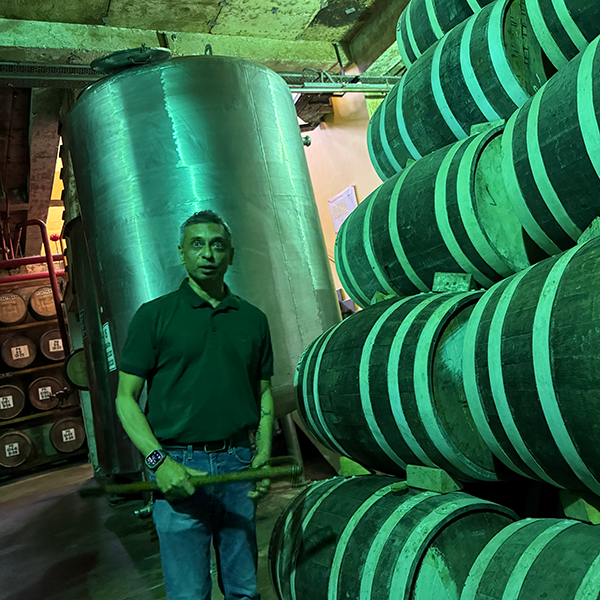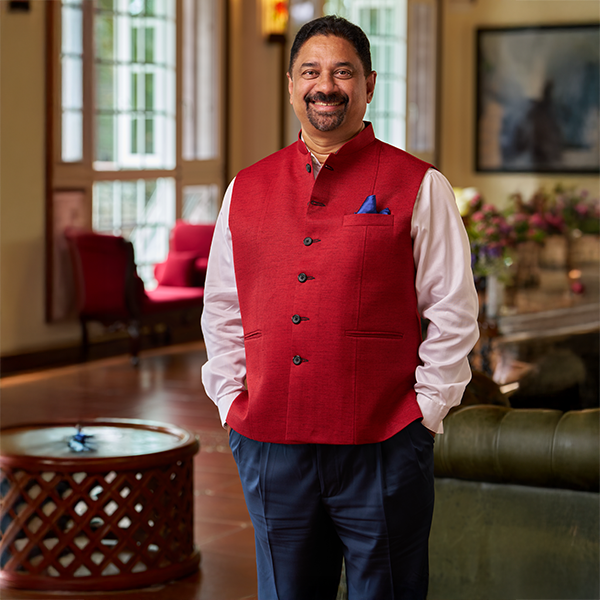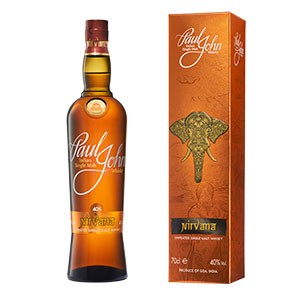
Photo by Cory Goldberg
The Science Behind Why Goan Whisky Matures Three Times Faster
At Paul John Distillery, India’s tropical heat and six-row barley create 3 year old whiskies that rival decade-old scotch. We visited to understand how.
November 17, 2025 –––––– Sean Evans
In the underground cellars of Paul John Distillery’s production facility in Goa, India, rest 3,500 casks, painted in a blueish hue by the overhead lighting. “These barrels mature more slowly in this area, so we’re using it for experimentation,” explains Paul John’s master distiller and blender Michael D’Souza, as he plunges a whisky thief into a barrel he’s just hammered open. “This is our whisky that’s been finishing in Caribbean rum casks from Foursquare,” he says, splashing some of the 14 year old liquid into my Glencairn.

It’s delicious, noticeably more delicate than the 3 to 7 year old core single malts that I just tried, which were aged in the warehouses above ground, where up to 30,000 casks are maturing in a total of five warehouses. Here, about seven miles from the Arabian Sea, Goa’s tropical climate transforms the liquid at such a rapid pace that it would lap scotch if it were a race. A Speyside warehouse loses 2% of its contents annually to evaporation. The Goan angels’ share? An astounding 8% average—a figure that seems catastrophic until you understand it's not a liability, but is actually the distillery’s greatest asset.

Tropical Maturation
“Every region has its pros and cons,” says D'Souza, as we stroll through one of the extremely humid rickhouses. “In Scotland, they have to age a minimum of 12 years [for decent-tasting whisky]. We can bottle within three years. Our Nirvana (label) is 3 years old from a fourth-fill cask, and I would say it’s as good as a 10 year old scotch.”
The mathematics of tropical maturation tells a compelling story about concentration and extraction. Paul John produces 10,000 liters of new make daily—1 million liters peated, 2 million unpeated annually. The new distillate enters barrels predominantly from the U.S. “Earlier, when we used casks from various distilleries—Jack Daniel, Heaven Hill, Maker's Mark, Four Roses—the evaporation varied depending on the charring and age of the cask.”
In 2017, Sazerac acquired an equity stake in Paul John, and now the distillery primarily uses Buffalo Trace barrels, something which has yielded greater consistency. D’Souza is quick to note, flavor-wise, that he vastly prefers Weller and Sazerac rye barrels: “Those give us the best whiskey.”
Shifting Into Single Malt
D’Souza’s been with John Distilleries Ltd. since it launched in 1992, primarily making what’s known as economy whisky or Indian-Made Foreign Liquor (IMFL), under the Original Choice label. Original Choice whisky, made from grain neutral spirit, became hugely popular, selling more than 11 million cases annually. By 2008, the Paul John Single Malt Distillery opened in Goa, and by 2012, the company’s first single malt was launched, landing positively in the Indian and international markets.
The distillery fills casks at 64% ABV, a number determined by chemistry. “We use six-row Indian barley compared to two-row Scottish grain,” D'Souza explains. “The chemical composition is different. Indian grain has lower carbohydrates, so the final ABV is 64%—that’s the maximum you can get from Indian grain.”
That six-row barley defines Paul John's character in ways beyond proof. The smaller grain size means higher husk content, and husks contain tannins that impart tropical and caramel notes. “Six-row is more grainy and tannic compared to two-row, which is more malty,” says D'Souza.”
It’s not the only Indian single malt distillery to use local barley: Indri and Amrut also use six-row barley, though Amrut blends it with two-row grains from Scotland. “Because there’s more surface on each piece of [Indian] grain, these tannins interact more and the whisky becomes mellower over time, imparting sweeter notes,” says D’Souza.

Paul John himself, the distillery's founder, emphasizes this distinction. “The six-row barley gives the whisky a stark difference—more oils in the husk that carry across to the bottles—but it’s also very Indian.” And that identity remains paramount to John, who works to reinforce it at every opportunity.
Working With Peat
That’s true even when using peat, which traditionally comes from Scotland. “We tried a lot of things to replace peat,” Paul John recalls. “Husk, other materials, including cow dung, which is made into cakes and used as fuel in villages. But it was too grassy.” (For peated expressions, Paul John imports everything from Scotland’s bogs.)
The cultural experimentation continues with wood. “We’re speaking to cask manufacturers in the U.S. about indigenous silver wood oak, which is reasonably available here,” says John. “Sandalwood is very Indian, very aromatic, but highly regulated and difficult to get.”
The wood is important for developing the right flavors. From bourbon barrels, tropical fruit notes emerge, including peach, pineapple, and banana, all common across the Paul John range, but particularly evident in Nirvana, the 3 year old 40% ABV expression, and Brilliance, a slightly older one at 46% ABV.

Younger offerings boast more floral notes of roses and lavender. Nuttier characteristics emerge in Classic (50% ABV), Bold, a lightly peated 46% option, and Peated (50% ABV). Compared to peated scotch, where peat likes to hog the spotlight, Paul John’s Bold and Peated offer more robust and sweeter variations, with ample dark fruits and tropical notes running concurrently with the smoke. Younger expressions have lime and lemon, which can move into more zesty orange marmalade as they age. “And there’s a manuka honey note that you’ll often find,” says D’Souza. Also present in the glass, thanks to Goa's warm, humid, salty sea breezes: a welcome minerality.

All expressions nose and taste beautifully, though Nirvana, at $30, is a true steal, considering it can stand toe-to-toe against scotches triple its age.
Extraction Is Key
Again, the pace of extraction drives everything. “One year in India is equivalent to four years from any core region, UK or U.S.,” D'Souza says. Maturation is simple: interaction, extraction, and evaporation. “In Scotland, the interaction is slow, extraction is slow. We don't have winter in India. We have uniform temperature throughout the year, so the extraction is 24/7, year-round. In Scotland, once the temperature drops below two degrees, everything [in the barrel] goes dormant. Technically, aging can’t happen throughout the year.”
“In Goa during the monsoon season, the walls [of our distillery] start sweating,” John adds. “There’s so much activity [in the barrels]. In the UK, it’s all frozen up for nine months.” This constant activity creates challenges, namely veering into overly tannic territory. “But we’re tasting frequently,” John says, to monitor the issue.
The distillery also vats and re-barrels many whiskies after six or seven years, to make sure they’re not overdone, reverting to third or fourth-fill casks. “Once the liquid hits 12 or 13 years, we start using fifth or sixth-fill barrels so it acquires flavor from wood but doesn't get overly tannic,” says John.
The 6 to 8-year aging window represents the distillery’s sweet spot, John thinks, when the character of the liquid is most evident. “Our single malt should be fruity, floral, with lots of caramel, toffee, and chocolate, giving you various bursts of flavor as you go along. Depending on the finishing casks, you should get plum, cherry, or dark chocolate,” he says. Paul John’s annual limited release, Christmas Edition, is a blend that is able to pull out all those flavors into one tidy, delectable dram, if our sample of the 2025 edition is any indication.
That’s not to say Paul John isn’t pushing upward to find bold Indian character well north of a decade. We could expect to see that 14 year old Caribbean cask bottled soon, and the demand for finished whiskies—sherry, port, and madeira—means there’s a slew of those finishing casks sleeping in the Paul John underground warehouse. There are a handful of muscatel casks that D’Souza recently filled, awaiting assessment in two years. And we tried a 16 year old whisky, still awaiting a name, that was positively delicious, full of banana, citrus zest, minerality, and maple syrup. Both John and D’Souza believe the whisky could handle two decades in wood, with diligence and re-barreling.
The largest challenge for John? “Education, especially in America,” he says of a market where single malt penetration remains relatively low. That American single malt was recently rewarded with an official category designation from the government offers some hope, but John still believes his task to be “Herculean. This is all about putting liquid on lips,” he says. “But I know once you try Paul John, there’s no looking back.”




